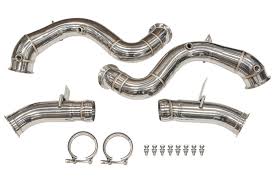For enthusiasts of high-performance German vehicles, the Mercedes AMG GT63 and Mercedes E63 are benchmarks of engineering, combining luxury with raw power. One of the most effective ways to enhance their performance is through aftermarket downpipe installations, which improve exhaust flow, reduce turbo lag, and elevate overall driving dynamics. This guide explores the benefits, installation considerations, and performance gains of upgrading downpipes on these AMG vehicles.
The mercedes amg gt63 downpipe install ↗ is a popular modification for owners seeking more power and a more aggressive exhaust note. The stock exhaust system, while refined and efficient, can be restrictive at higher RPMs. Installing an aftermarket downpipe allows exhaust gases to exit the system more freely, reducing backpressure and allowing the turbos to spool faster. This translates into sharper acceleration, increased horsepower, and improved throttle response. Many AMG GT63 owners combine this upgrade with an ECU tune to safely optimize engine performance, ensuring the car delivers both speed and precision without compromising reliability.
 Material and design are critical when upgrading the AMG GT63 downpipe. Stainless steel construction is preferred due to its durability and resistance to high temperatures. Mandrel-bent tubing ensures smooth airflow, preventing turbulence that could reduce turbo efficiency. Some tuners opt for high-flow catted downpipes, which maintain emissions compliance while improving performance, while catless versions are designed for track-focused vehicles seeking maximum gains. Professional installation is recommended, as the downpipe connects directly to sensitive turbo components and requires precise torque specifications for optimal function.
Material and design are critical when upgrading the AMG GT63 downpipe. Stainless steel construction is preferred due to its durability and resistance to high temperatures. Mandrel-bent tubing ensures smooth airflow, preventing turbulence that could reduce turbo efficiency. Some tuners opt for high-flow catted downpipes, which maintain emissions compliance while improving performance, while catless versions are designed for track-focused vehicles seeking maximum gains. Professional installation is recommended, as the downpipe connects directly to sensitive turbo components and requires precise torque specifications for optimal function.
Shifting focus to the mercedes e63 downpipe install ↗ , this upgrade offers similar benefits tailored to the sedan or wagon’s platform. The E63’s twin-turbo V8 engine thrives when paired with upgraded exhaust components. A performance downpipe improves exhaust flow, reduces turbo lag, and enhances overall engine responsiveness. Drivers frequently report not only measurable gains in horsepower and torque but also a more engaging and aggressive exhaust note that complements the AMG character. For enthusiasts who enjoy spirited driving or track sessions, this modification significantly improves the vehicle’s driving dynamics.
Installing downpipes on the E63 requires careful preparation and mechanical expertise. The car must be securely elevated, and stock exhaust components removed carefully to avoid damage to the turbo system. Stainless steel downpipes with precise bends ensure both durability and optimal airflow. Many performance enthusiasts also pair the installation with ECU tuning to maximize gains, allowing the E63 to deliver its full potential safely and reliably. This combination of mechanical and electronic enhancements ensures a well-rounded performance upgrade.
Beyond measurable performance improvements, upgrading downpipes on both the AMG GT63 and E63 enhances the overall driving experience. Reduced backpressure improves throttle response and smoothens power delivery, creating a more dynamic and engaging ride. The auditory enhancement, featuring a deeper and more aggressive exhaust tone, adds an emotional dimension to driving, reinforcing the AMG’s performance-focused identity. Whether navigating winding roads, highways, or track circuits, these upgrades elevate both performance and driving enjoyment.
In conclusion, installing high-quality downpipes on a Mercedes AMG GT63 or Mercedes E63 is an effective way to unlock the full potential of these performance vehicles. From increased horsepower and reduced turbo lag to improved exhaust sound and throttle response, the benefits are substantial. Selecting the right materials, ensuring professional installation, and optionally pairing the upgrade with ECU tuning maximize both reliability and performance. For enthusiasts seeking to enhance the power, sound, and driving experience of their AMG, downpipe upgrades represent a precise and rewarding modification.